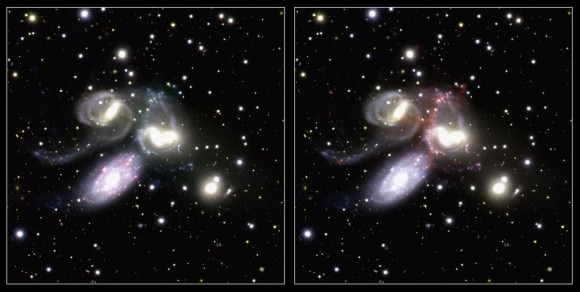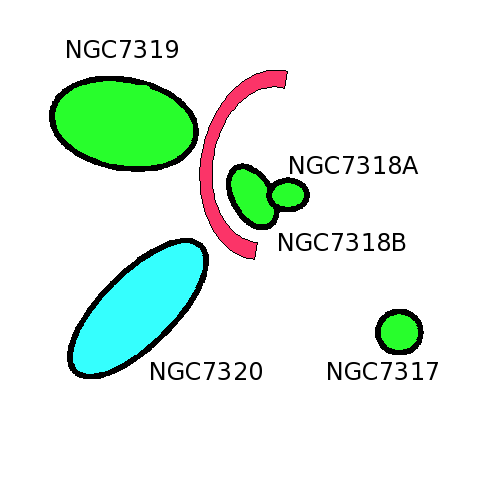
Composite tricolor images of Stephan's Quintet using H-alpha filters with a recession velocity of 0 (left image) and a recession velocity of 4,200 miles per second (right image).
While this isn’t a true “cross eye” image, you can darn sure open the larger version, set it to screen size, cross your eyes and get a pretty astonishing result. If you don’t “get it”, then don’t worry. Just look at the pictures separately, because the Subaru Telescope has added a whole new dimension to a seasonal favorite – Stephen’s Quintet. Located in the constellation of Pegasus (RA 22 35 57.5 – Dec +33 57 36), this awesome little galaxy group also known as HIckson Compact Group 92 and Arp 319. In visual observation terms, there’s five – but only four are actually a compact group. The fifth is much closer…
While literally volumes could be written about this famous group, the focus of this article is on the latest observations done by the Subaru Telescope. Each time the “Quints” are observed, it would seem we get more and more information on them! By employing a variety of specialized filters with Subaru’s Prime Focus Camera (Suprime-Cam), the two above images reveal different types of star-formation activity between the closer galaxy – NGC7320 – and the more distant members. It captures Stephen’s Quintet in three dimensions.
So how is it done? Suprime-Cam has the capability of wide field imaging. By utilizing specialized filters, researchers can narrow the photographic process to specific goals. In this instance, they use narrowband filters to reveal star-forming regions within the grouping and their structures. These H-alpha filters are very specific – only allowing a particular wavelength of light to pass through – revealing the hydrogen emissions of starbirth. But here’s the tricky part. The images were taken with two different types of H-alpha filters – each one with a different recession velocity. With a setting of zero, we have an object which is moving away from the observer and close. The other has a greater recession velocity of 4200 miles (6,700 km) per second. This is an indicator of distant objects. For a color palette, red indicates the H-alpha emission lines while blue and green colors assigned to the images from the blue and red filters captured light so that the composite tricolor images aligned with human color perception in red, green, and blue.
When processed, we get the two different views of Stephen’s Quintet as seen above. Says the imaging team; “The image on the left shows the galaxies when the observers used the Ha filter with a recession velocity of 0 while the one on the right shows them when they used the Ha filter with a recession velocity of 4,200 miles per second. The left image shows Ha emissions that indicate an active star-forming region in the spiral arms of NGC7320 in the lower left quadrant but not in the other galaxies. The right image contrasts with the left and shows a region of H-alpha emissions in the upper three galaxies but none from NGC7320. Two (NGC7318A and NGC7318B) of the four galaxies are shedding gas because of a collision while a third (NGC7319) is crashing in, creating shock waves that trigger vigorous star formation.”
But that’s not all. In the figure below we can see the relationship of the galaxies. “Gas stripped from these three galaxies during galactic collisions is ionized by two mechanisms: shock waves and strong ultraviolet light emanating from the newborn stars.” reports the Subaru team. “This ionized gas emits bright light, which the H-alpha filter reveals. Thus the researchers believe that NGC7319 as well as NGC7318A/B are driving the star-forming regions in the Ha emitting region around NGC7318A/B.”

A diagram of the member galaxies of Stephan's Quintet. NGC7320 is a closer galaxy and has a recession velocity of 0. The remaining four are a group of more distant galaxies 300 million light years away. The researchers believe that the merging of NGC7318A/B and NGC7319's crashing into them are responsible for the active star formation regions in the Ha emitting region around NGC7318A/B.
But star-forming activity isn’t all you can derive from these images – they are also an indicator of distance. By exposing opposing recession velocities in the same image, observers are able to deduce where objects are located at different distances, yet close to each other. “The contrasting images show that NGC7320 is closer than the other galaxies, which show active star formation at a significantly higher recession velocity (4,200 miles per second) than NGC7320 (0).” explains the team. “NGC7320 is about 50 million light years away while the other four galaxies are about 300 million light years away. This explains the intriguing arrangement of the galaxies in Stephan’s Quintet.”
Now is a great time to observe this cool cluster of galaxies for yourself… Before the Moon interferes again!
Original Story Source: Subaru Telescope Press Release.
Source: Universe Today
No hay comentarios:
Publicar un comentario